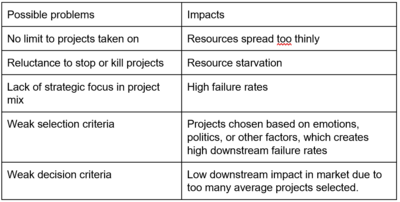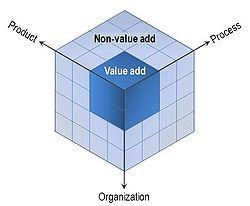A product rationalization project part of a portfolio optimization program
(→Background) |
(→Background) |
||
| Line 17: | Line 17: | ||
[[File:Complexity Cube.jpg|right|250px|thumb|Figure 1 - The Complexity Cube.<ref name="Complexity Cube"> | [[File:Complexity Cube.jpg|right|250px|thumb|Figure 1 - The Complexity Cube.<ref name="Complexity Cube"> | ||
| − | Perumal, W. and Company (2013) How is complexity impacting your retail business? Available at: http://www.wilsonperumal.com/blog/how-is-complexity-impacting-your-retail-business/.</ref>]]There | + | Perumal, W. and Company (2013) How is complexity impacting your retail business? Available at: http://www.wilsonperumal.com/blog/how-is-complexity-impacting-your-retail-business/.</ref>]]There exist two types of complexity i.e. good and bad complexity. As customers demand more value, it is inevitable not to build a certain amount of complexity. Customers are willing to pay for this type of complexity, hence it represents good complexity. On the other hand, customers are not willing to pay for complexity that reduces their experience, hence it represents bad complexity. |
The complexity cube framework describes how complexity develops from three interdependent dimensions. The ability to understand and identify from where complexity develops in the specific organizations increases the ability to analyze and remove it. The key takeaway from the complexity cube, see figure 1, is that the issues of complexity originates from the intersections between the dimensions and the costs associated with complexity is multiplicative between the dimensions, hence the effort to reduce complexity should be focused on multiple dimensions to create impact. The complexity costs grow exponentially with greater levels of complexity, hence organizations that can deliver good complexity and reduce or even eliminate bad complexity will create a sustainable competitive advantage. They will create an advantage because they will be significantly more profitable and the skills to manage complexity are difficult to replicate.<ref name="Waging war">Wilson, A. S., & Perumal, A. (2010). Waging war on complexity costs. McGraw-Hill.</ref> | The complexity cube framework describes how complexity develops from three interdependent dimensions. The ability to understand and identify from where complexity develops in the specific organizations increases the ability to analyze and remove it. The key takeaway from the complexity cube, see figure 1, is that the issues of complexity originates from the intersections between the dimensions and the costs associated with complexity is multiplicative between the dimensions, hence the effort to reduce complexity should be focused on multiple dimensions to create impact. The complexity costs grow exponentially with greater levels of complexity, hence organizations that can deliver good complexity and reduce or even eliminate bad complexity will create a sustainable competitive advantage. They will create an advantage because they will be significantly more profitable and the skills to manage complexity are difficult to replicate.<ref name="Waging war">Wilson, A. S., & Perumal, A. (2010). Waging war on complexity costs. McGraw-Hill.</ref> | ||
Revision as of 15:53, 10 September 2016
Product proliferation enables organization to serve customers´ varying requirements and needs as well as attracting new customers. By expanding the product portfolio organizations can capture new revenue sources and build and sustain a competitive advantage. Some organizations pursue the strategy of diversifying the product portfolio without fully understanding the extent to which implications can occur e.g. as new product variants are added complexity increases and higher costs are introduced in the supply chain.
When the portfolio consists of too many products, it becomes critical to the cost competitiveness of the organization to effectively manage and control the products in the portfolio. Through intelligent product rationalization by focusing on incremental revenue, incremental cost and a lifecycle perspective, it is possible to minimize revenue loss but ensure significant cost reductions, hence reducing complexity in the portfolio.[1] Additionally, prioritization and selection of products becomes essential to ensure alignment with the business strategy.
SKU rationalization is central to reduce complexity costs and thereby optimize and control the portfolio. Many companies have adopted complexity management approaches to reduce complexity costs and increase competitiveness. The aim of this article is to examine thoroughly the use of portfolio optimization in regards to SKU rationalization as a method to reduce complexity, control the portfolio and release resources. As a result, it is possible to maximize the strategic organizational goals by reinvesting in future projects to strengthen the portfolio while obeying budgetary restrictions.
Contents |
Background

SKU rationalization is the process of eliminating projects that contributes negatively to the strategic organizational goal. Before SKU rationalization is elaborated, it is important to understand how product proliferation and poor portfolio management in tandem introduce complexity, why rationalization is a powerful tool in the process of regaining control over the portfolio, and when it is applicable to your business.
When organizations proliferate their product variety to fulfill the market demand but also to establish barriers to entry as it leaves little space for potential entrants.[3][4] This enables the organizations to prevent entry in mature organizations as well as capturing new revenue sources and sustaining profitable growth through a competitive advantage.[5][6] When expanding the product diversity without proper portfolio management several problems may occur. The problems in table 1 is a result from incoherent evaluations of new projects which fail to both review economic and non-economic risk and rewards across a set of projects and to ensure the projects are balanced in the portfolio.[2]

The complexity cube framework describes how complexity develops from three interdependent dimensions. The ability to understand and identify from where complexity develops in the specific organizations increases the ability to analyze and remove it. The key takeaway from the complexity cube, see figure 1, is that the issues of complexity originates from the intersections between the dimensions and the costs associated with complexity is multiplicative between the dimensions, hence the effort to reduce complexity should be focused on multiple dimensions to create impact. The complexity costs grow exponentially with greater levels of complexity, hence organizations that can deliver good complexity and reduce or even eliminate bad complexity will create a sustainable competitive advantage. They will create an advantage because they will be significantly more profitable and the skills to manage complexity are difficult to replicate.[1]
Why product complexity arises
The need to regain control
How to regain control
How do you know if your have complexity?
ABC analysis
Incremental revenue Incremental cost A lifecycle perspective
SKU rationalization
Step 1
Step 2
Step 3
Step 4
Implications
How to fight complexity creep
Capability building Selection and decision models Other courses of complexity
==
Testing referencing.[8]
References
- ↑ 1.0 1.1 Wilson, A. S., & Perumal, A. (2010). Waging war on complexity costs. McGraw-Hill.
- ↑ 2.0 2.1 Tidd, J. and Bessant, J. (2013) Managing innovation: Integrating technological, market and organizational change. 5th edn. United States: Wiley, John & Sons. Page 338-339.
- ↑ Schmalensee, R. 1978. Entry deterrence in the ready-to-eat breakfast cereal industry. Bell Journal of Economics, 9: 305–327.
- ↑ Smiley, R. 1988. Empirical evidence on strategic deterrence. International Journal of Industrial Organization, 6: 167– 180.
- ↑ Mascarenhas, B., Kumaraswamy, A., Day, D., & Baveja, A. 2002. Five strategies for rapid firm growth and how to implement them. Managerial and Decision Economics, 23: 317–330.
- ↑ Pichler, H., Vienna, Dawe, P. and Edquist, L. (2014) Less can be more for product portfolios. Available at: https://www.bcgperspectives.com/content/articles/lean_manufacturing_consumers_products_less_can_be_more_product_portfolios/.
- ↑ Perumal, W. and Company (2013) How is complexity impacting your retail business? Available at: http://www.wilsonperumal.com/blog/how-is-complexity-impacting-your-retail-business/.
- ↑ Remember that all the texts will be included into the reference containing the name= attribute.